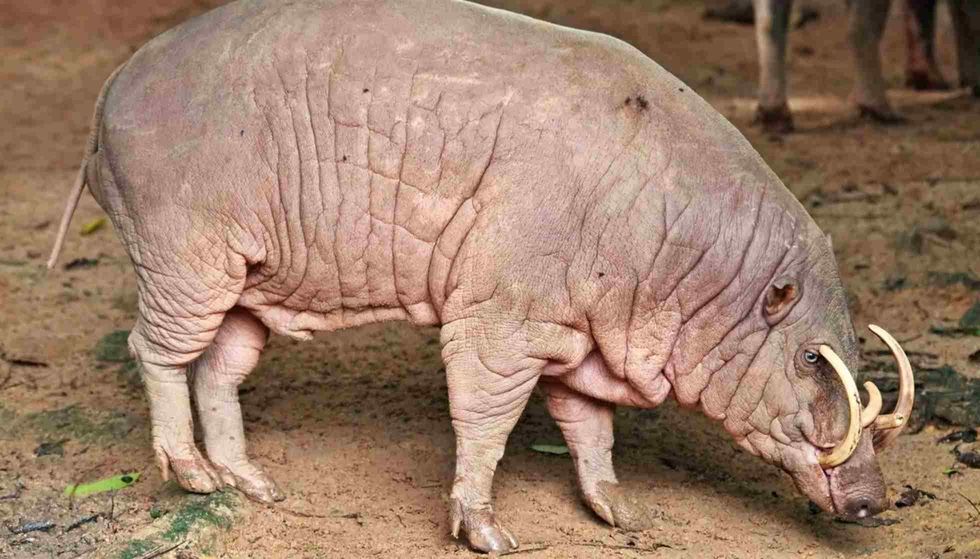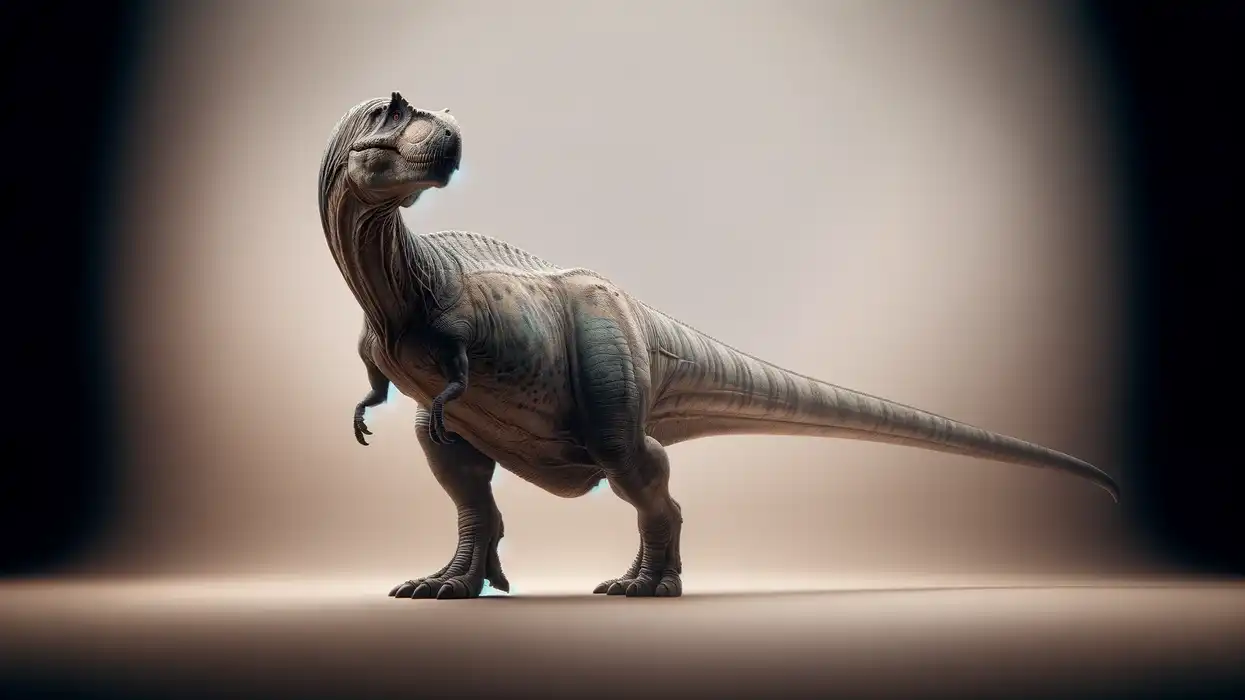Did you think that all prehistoric animals might have gone extinct by now? If so, then you are yet to hear about one of the most unique species of pigs that walk the Earth.
We are talking about the Babirusa, a species endemic to the Indonesian islands of Sulawesi, Togian, Buru, and Sula. They enjoy living in the Indonesian rain forest, especially near the banks of a river.
The main characteristic of the Babirusa has to be their long upper tusks and lower tusks. These tusks keep on growing throughout their life, and they need to grind them to keep them in shape.
The animal has a barrel-like body and looks quite similar to that of a domesticated pig.
Female Babirusas have one or two piglets in a year, and they live in big groups. Meanwhile, the male Babirusa is a solitary being that only comes in contact during the mating season.
Even though Babirusas have lived in their native lands without facing any threats, they are currently enlisted as Vulnerable in the International Union for Conservation of Nature (IUCN) conservation list because of the loss of their habitats and hunting. Keep on reading to know more about these fascinating animals.
Loved the Babirusa facts? Check out the articles on Javan rhinoceros and tamandua.
Babirusa Interesting Facts
What type of animal is a Babirusa?
Babirusa belongs to the Suidae, or the swine family, and they are native to Indonesia.
What class of animal does a Babirusa belong to?
Babirusa belongs from the class Mammalia and from the order Artiodactyla.
How many Babirusas are there in the world?
Around 10,000 Babirusas are said to be left in their wild native habitat of Togian, Sula, and Buru islands of Indonesia.
Where does a Babirusa live?
Babirusas like to live in Tropical rainforests that are near a ready water source. They originate from the Indonesian islands of Sulawesi, Togian, Buru and Sula.
What is a Babirusa's habitat?
Babirusas like to spend their life in a forest habitat that is nearby to river banks. Babirusas may have also lived in the low-lying coastal areas, but they are currently confined to the upper areas.
In their native habitat, the Babirusa enjoys a predator-free environment. As they like to live near the waters, Babirusas also tend to swim and even hunt for fish with the help of their tusks.
Who do Babirusas live with?
Babirusas are solitary animals who may at times live in bachelor groups. Babirusa males usually enjoy being solitary animals though the females are often seen with their young. Groups of female Babirusas can go up to 84 individuals. Babirusa males do not take part in raising their kids.
How long does a Babirusa live?
Babirusas usually live to be 10 years old in the wild. However, some humans have managed to keep the Babirusa pig alive for 24 years.
How do they reproduce?
Babirusa females have estrus (heat) cycles that last for two to three days. The usual mating season of Babirusas is from January to August.
The Babirusa males fight it off with their iconic top of the snout tusks to win the females. The gestation period for a Babirusa lasts 155-158 days, and they give birth to one or two Babirusa piglets.
Compared to other pigs, Babirusas do have a very small litter size. It may take eight months for the piglets to wean from their mother.
It takes two years for a Babirusa to reach sexual maturity. The piglets of a Babirusa (Babyrousa babyrussa) develop fairly quickly, and the piglets are able to explore their surroundings within ten days of birth.
What is their conservation status?
According to the International Union for Conservation of Nature or IUCN Red List, all species of Babirusas are noted as Vulnerable. Though they live in a predator-free environment, humans have started to hunt them for various reasons.
Babirusa Fun Facts
What do Babirusas look like?
On laying your eyes on a Babirusa, you are bound to think of a prehistoric animal because of their top of the snout tusks or teeth. Their body looks quite similar to that of a domesticated pig, but their big upper tusks do take away all the attention.
Babirusa in the Malay language means 'pig deer,' and the confusion is quite apparent on seeing the species. You will be really shocked to know that the tusks literally grow by perforating the skin of their snout.
The males have to keep on filing their tusks, or else Babirusa tusk death can easily happen. The iconic upper tusks are only seen in the males of the species.
Though no specific reasons have been found for their special teeth, the upper tusks are used by the males for fighting during the mating season. Babirusas have thick wrinkly skin of a grayish or brownish color.
Hair is sparsely distributed on their body.
The Babirusas have a narrower snout, and they only dig with it in swampy or muddy grounds. Babirusa lacks the rostral bone of their snout, so they need to be a little careful about fighting with other males.
The tusks of the males can grow up to 12 in or 30 cm, and the upper canines have a curvature to them. Like other pigs, Babirusas have strong hind legs.
One of the interesting Babirusa pig facts is that their hind legs almost look like that of a deer. They have small ears and a cute little tail.

How cute are they?
Well, the long upper canines of a male Babirusa may make you feel intimidated. However, like all other pigs, Babirusas are pretty cute.
They have a perpetually smiling face which is enhanced by their narrow muzzles. You can easily get past the tusks and teeth to find the cute pig that they are. The piglets look even cuter when they roll around in the mud.
How do they communicate?
Like many other pigs, the Babirusas communicate with the help of vocal sounds like grunts and moans. They can even communicate via chattering of teeth.
Babirusas also participate in something known as the 'plowing behavior'. This is especially predominant in male Babirusas who dig their snout in the sand and create foam with their saliva while creating vocal noises. The purpose of this behavior in male Babirusas is yet to be known.
How big is a Babirusa?
The average head-body length of a Babirusa is 33-43 in (85-110 cm), and their average height is 24 in (61 cm). They are two times smaller than the Wild Boar that can attain a height of 21-47 in (55-120 cm) and a head-body length of 35-75 in (90-200 cm).
How fast can a Babirusa move?
Though the exact speed of a Babirusa pig isn't known, because of their similar size, they can have a comparable speed to that of domestic pig, which averages at 11 mph or 18 kmph.
How much does a Babirusa weigh?
Babirusa pigs can weigh anywhere around 94.7-220.3 lb (43-100 kg).
What are their male and female names of the species?
Like other members of the swine family, a male Babirusa is known as a boar, and a female Babirusa is known as a sow.
What would you call a baby Babirusa?
A baby Babirusa is called a piglet.
What do they eat?
Like other members of the pig family, the Babirusa has an omnivorous diet in the wild. The species feeds on leaves, fruits, insects, fish, and small mammals. Babirusas are also known for their ability to crack hard forest nuts with their strong jaws. They mainly look for food during the morning hours and prefer lazing away in the afternoon.
Are they dangerous?
As wild animals, Babirusas may get dangerous if they are made to behave aggressively. They only fight with each other during the mating season. Other than that, Babirusas do have a calm attitude, and humans have domesticated them in Indonesia.
Would they make a good pet?
They do make good pets for people who live in the specific Indonesian islands. In the Malay language, the word Babirusa means 'pig deer.'
They have long been caught from the wild forest and domesticated especially for their meat. The native people from the islands are also fascinated by huge tusks.
However, as they are endemic to the Indonesian islands, the species won't be legal to keep for anyone else who is outside their natural habitat. However, some zoos like the Saint Louis Zoo and the San Diego Zoo have Babirusas.
Did you know...
Native Indonesians make demon skulls in the shape of the Babirusa skull.
Paintings of Babirusas have been found on the walls in caves of the Indonesian island of Sulawesi. The paintings are at least 35,400 years old, belonging probably from the Pleistocene epoch.
One of the Babirusa interesting facts is that some scientists think that the Babirusa is more closely connected to the hippopotamus than to pigs.
There is a tale about Babirusas hooking their tusks on a lower branch of a tree to fall asleep, but it is sheer imagination. Babirusas enjoys sleeping on the ground like other swine family members.
Why is the Babirusa endangered?
Babirusa pigs are currently regarded as Vulnerable according to the International Union for Conservation of Nature or IUCN Red List. There are about 10,000 of them left in the wild forest habitat.
They are mainly hunted because of their wonderful upper tusks and lower tusks. However, some also kill Babirusas as they are thought to be a pest for farmlands. They are also threatened by habitat loss.
Unique features of the Babirusa
The huge upper tusks and lower tusks of the Babirusa pigs are mainly seen in the North Sulawesi babirusa (Babyrousa celebensis). If a Babirusa forgets to grind its upper or lower tusks, it may face the horror of being impaled by its own tusks.
Here at Kidadl, we have carefully created lots of interesting family-friendly animal facts for everyone to discover! Learn more about some other mammals including pot belly pig, or plains zebra.
You can even occupy yourself at home by drawing one on our babirusa coloring pages.









